“On, King! On, you huskies!”
The Detroit, Michigan station known as WXYZ—“the last word in radio”—was already responsible for introducing two dramatic programs over the airwaves that became firm favorites with radio listeners. The first of these was a simple juvenile adventure that began broadcasting in 1933, detailing the exploits of a masked individual who “led the fight for law and order in the early Western United States”—The Lone Ranger. Three years later, The Green Hornet updated the Ranger formula to the modern era as its titular hero also battled forces determined to undermine society with rampant crime. Seventy-nine years ago on this date, “Wyxie Wonderland” introduced the last series in their triumvirate of heroes: Challenge of the Yukon.
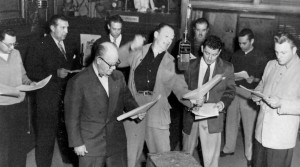 Author Gerald Nachman jokingly refers to Challenge of the Yukon in his book Raised on Radio as “the Lone Ranger on ice.” But there’s a little bit of truth behind this jocularity. George W. Trendle, the station owner of WXYZ, was determined to create another radio drama along the lines of The Lone Ranger…the only difference was he wanted a dog to be the hero. It wasn’t a canine in the Lassie mold that G.W. had in mind…he insisted that his dog be a working dog (why he was believed that Lassie was on the dole remains a mystery). The proposed setting for the new series was the Northwest…and a working dog in that neck of the woods would unquestionably be an Alaskan husky.
Author Gerald Nachman jokingly refers to Challenge of the Yukon in his book Raised on Radio as “the Lone Ranger on ice.” But there’s a little bit of truth behind this jocularity. George W. Trendle, the station owner of WXYZ, was determined to create another radio drama along the lines of The Lone Ranger…the only difference was he wanted a dog to be the hero. It wasn’t a canine in the Lassie mold that G.W. had in mind…he insisted that his dog be a working dog (why he was believed that Lassie was on the dole remains a mystery). The proposed setting for the new series was the Northwest…and a working dog in that neck of the woods would unquestionably be an Alaskan husky.
 From that, it was just a short step to the inspiration of pairing that dog with a Canadian Mountie…and the concept of Challenge of the Yukon was born. The show’s background drew heavily on The Lone Ranger: to avenge the murder of his father, young William Preston joins the Northwest Mounted Police and successfully captures the senior Preston’s killer. Impressed with Preston’s skills, the Mounties promote him to the rank of sergeant and assign him a faithful lead sled dog named Mogo.
From that, it was just a short step to the inspiration of pairing that dog with a Canadian Mountie…and the concept of Challenge of the Yukon was born. The show’s background drew heavily on The Lone Ranger: to avenge the murder of his father, young William Preston joins the Northwest Mounted Police and successfully captures the senior Preston’s killer. Impressed with Preston’s skills, the Mounties promote him to the rank of sergeant and assign him a faithful lead sled dog named Mogo.
Yes, I know what you’re thinking: “If the dog’s name was ‘Mogo,” shouldn’t the title of this post would be different?” “Mogo” was the original name of Preston’s devoted canine, but George W. Trendle insisted that the dog’s name be changed to “King.” This may have been a tribute to author Zane Grey (of whom Trendle was a fan) and his heroic character Dave King. (Zane would go on to his greater reward about a year after Challenge of the Yukon’s radio debut).
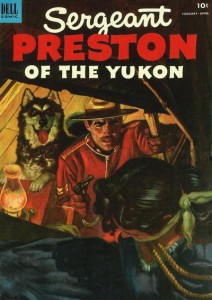 Employed against the colorful background of the Klondike gold rush, the square-jawed (okay, maybe it was kind of hard to tell on radio but you just sort of knew Preston had one), straight-shooting Sergeant Preston and his “wonder dog” were responsible for policing a large area known as “Forty Mile.” (In the early years of Challenge of the Yukon, the duo was assisted by a French-Canadian guide named Pierre…though he was eventually dropped from the program.) The presence of gold frequently led less-than-honest men to severely test the boundaries of law and order…and that’s when Preston and King would swing into action, swiftly bringing those miscreants to justice. Like its siblings The Lone Ranger and The Green Hornet, Challenge resorted to borrowing a little music from the public domain for its theme song: Emil von Reznicek’s Donna Diana Overture (which had previously been featured on Ranger as background and bridge music).
Employed against the colorful background of the Klondike gold rush, the square-jawed (okay, maybe it was kind of hard to tell on radio but you just sort of knew Preston had one), straight-shooting Sergeant Preston and his “wonder dog” were responsible for policing a large area known as “Forty Mile.” (In the early years of Challenge of the Yukon, the duo was assisted by a French-Canadian guide named Pierre…though he was eventually dropped from the program.) The presence of gold frequently led less-than-honest men to severely test the boundaries of law and order…and that’s when Preston and King would swing into action, swiftly bringing those miscreants to justice. Like its siblings The Lone Ranger and The Green Hornet, Challenge resorted to borrowing a little music from the public domain for its theme song: Emil von Reznicek’s Donna Diana Overture (which had previously been featured on Ranger as background and bridge music).
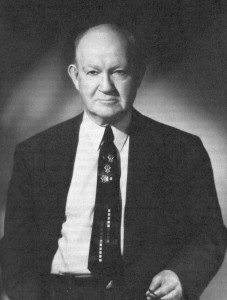 Challenge of the Yukon employed many of the same actors from Trendle’s other dramatic creations. John Todd, who played the faithful Indian companion Tonto on The Lone Ranger, and the elderly version of Dan Reid on The Green Hornet, essayed the role of Inspector Conrad (Preston’s superior). Brace Beemer took over as Sergeant Preston in the series’ final year, once his stint as the Lone Ranger came to an end. The first actor to play Preston was Jay Michael, who voiced the heroic Mountie during the years the program aired as a quarter-hour in Detroit (when the show moved to the ABC network in June of 1947 it expanded to a half-hour). Although Michael would eventually be replaced by Paul Sutton in the lead role, he would later be pressed into serving as Challenge’s announcer until the series concluded on June 9, 1955. (King’s barking came courtesy of soundman Dewey Cole.)
Challenge of the Yukon employed many of the same actors from Trendle’s other dramatic creations. John Todd, who played the faithful Indian companion Tonto on The Lone Ranger, and the elderly version of Dan Reid on The Green Hornet, essayed the role of Inspector Conrad (Preston’s superior). Brace Beemer took over as Sergeant Preston in the series’ final year, once his stint as the Lone Ranger came to an end. The first actor to play Preston was Jay Michael, who voiced the heroic Mountie during the years the program aired as a quarter-hour in Detroit (when the show moved to the ABC network in June of 1947 it expanded to a half-hour). Although Michael would eventually be replaced by Paul Sutton in the lead role, he would later be pressed into serving as Challenge’s announcer until the series concluded on June 9, 1955. (King’s barking came courtesy of soundman Dewey Cole.)
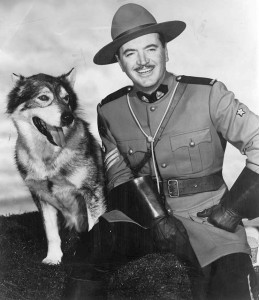 In November of 1951, Challenge of the Yukon officially changed its name to Sergeant Preston of the Yukon in honor of its main character…and I’ve always wondered if King placed a call to his agent not long afterward, because in all honesty the dog did most of the heavy lifting. (“Well, King—thanks to you, this case is closed,” Preston would frequently inform his four-legged pal at the end of the show. The defense rests, Your Honor.) Sergeant Preston made a successful transition to the small screen in the fall of 1955 with a TV version that starred Richard Simmons (not the exercise guru) and ran on CBS until 1958.
In November of 1951, Challenge of the Yukon officially changed its name to Sergeant Preston of the Yukon in honor of its main character…and I’ve always wondered if King placed a call to his agent not long afterward, because in all honesty the dog did most of the heavy lifting. (“Well, King—thanks to you, this case is closed,” Preston would frequently inform his four-legged pal at the end of the show. The defense rests, Your Honor.) Sergeant Preston made a successful transition to the small screen in the fall of 1955 with a TV version that starred Richard Simmons (not the exercise guru) and ran on CBS until 1958.
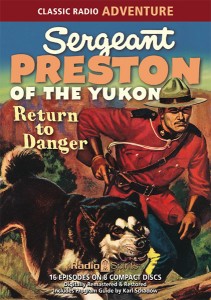 To celebrate the anniversary of our favorite Mountie (it was close, but he beat Dudley Do-Right by a mere handful of votes), Radio Spirits invites to check out our inventory of Sergeant Preston of the Yukon collections—many of which feature previously uncirculated episodes! We offer Treacherous Adventures, On, You Huskies!, King Takes Over, Relentless Pursuit, and Frozen Trails…and soon, a new Preston set in Return to Danger will be available (keep an eye out for it!). Our Yuletide compendium Radio’s Christmas Celebrations also featured a holiday-themed outing of the series entitled “The Sergeant’s Present” (12-23-49). There’s no greater outlet for radio adventure than a journey to the ice and snow of the Great Northwest with “stout-hearted man” Sergeant Preston and his heroic sled dog, Yukon King!
To celebrate the anniversary of our favorite Mountie (it was close, but he beat Dudley Do-Right by a mere handful of votes), Radio Spirits invites to check out our inventory of Sergeant Preston of the Yukon collections—many of which feature previously uncirculated episodes! We offer Treacherous Adventures, On, You Huskies!, King Takes Over, Relentless Pursuit, and Frozen Trails…and soon, a new Preston set in Return to Danger will be available (keep an eye out for it!). Our Yuletide compendium Radio’s Christmas Celebrations also featured a holiday-themed outing of the series entitled “The Sergeant’s Present” (12-23-49). There’s no greater outlet for radio adventure than a journey to the ice and snow of the Great Northwest with “stout-hearted man” Sergeant Preston and his heroic sled dog, Yukon King!

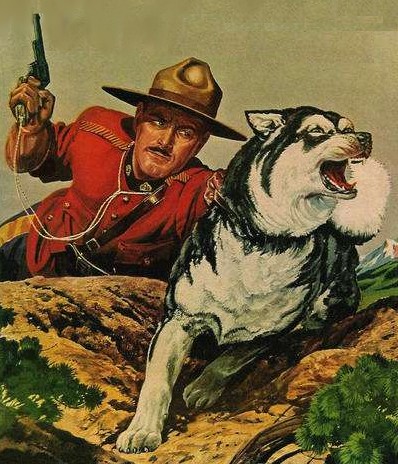

You can remove any mention of “Lassie” from this equation since “Yukon King’s” Feb. 1938 debut pre-dated “Lassie’s” arrival that same year in the Dec. 18 issue of the “Saturday Evening Post.” Eric Knight’s expanded tale was published in novel form in 1940, but not until 1943 did a Tootsie-like Hollywood star turn by a male collie named “Pal” forever cement “Lassie’s” reputation as a sable & white MGM “diva.” Prior to the movie, “print Lassie” was depicted as a tri-color female. Growing up in northwest Ohio in the Forties, I was an eager fan of all three WXYZ dramas — especially Sergeant Preston — but “King” lost out when I got my first collie in 1949. “Scout” — a tri like “print Lassie” — is my eighth!